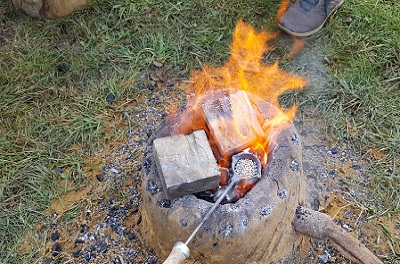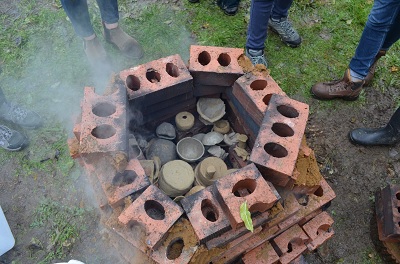A sit down with Dr Nathaniel Erb-Satullo
26/01/2021
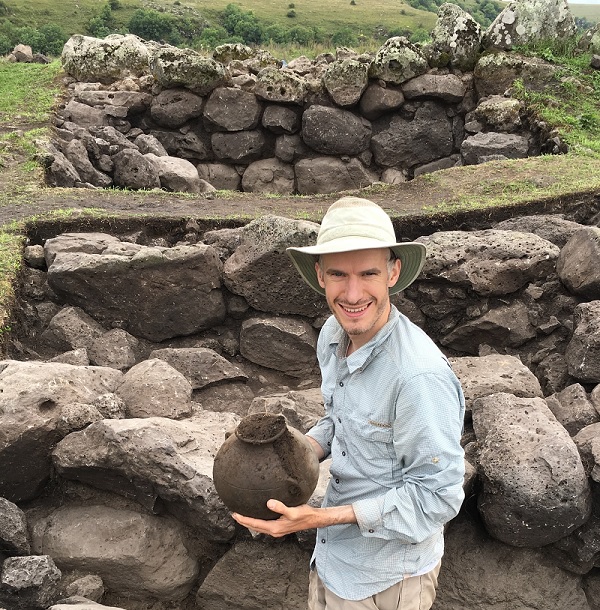
Last year Dr Nathaniel Erb-Satullo joined Cranfield as lecturer in Archaeological Science at the Cranfield Forensic Institute, find out more about his Cranfield journey so far..
Can we learn more about your area of research, how this relates to CFI?
Broadly speaking, my research focuses on reconstructing ancient and technologies, innovation processes, and the dynamics of social change. Methodologically, I use laboratory analytical techniques such as microscopy and chemical analysis, as well as the methods of geospatial analysis (GIS) to understand social and economic systems. I have a specific focus on ancient pyro technologies, primarily metallurgy, but also ceramics and vitreous materials, complementing existing strengths in archaeological and historic materials analysis within CFI. Geographically, much of my research focuses on the ancient Near East, especially the Caucasus region. My approach to research is distinctive for its methodological breadth, involving both laboratory research, field survey, and excavation, which help to contextualize the innovation processes within their broader social framework.
As an example, for a recent paper of mine in the Journal of Archaeological Science, I directed a project the found and excavated early iron metallurgical remains at a hilltop fortress. I then analysed the metallurgical slags from the site in the lab to reveal the workflow integration of bronze and iron metalworking at an early stage of iron adoption. The intertwining of bronze and iron economies has implications for models of innovation and how different technological systems intersect with one another. From a methodological standpoint, the integration of field and laboratory research ensures that analytical data are properly situated within their archaeological context—an essential consideration for investigating the socially-contingent processes of innovation.
Why did you choose Cranfield?
CFI has long had a reputation for expertise in the scientific analysis of archaeological and historic materials, and recent hiring trends have strengthened these capacities. Indeed, one of my first research experiences as an MSc. student at Oxford was collaborating with Andrew Shortland (now CFI Director) on a project analysing ceramics from the Mesopotamian site of Nuzi. Andrew’s approach to archaeological materials analysis—using robust science to probe topics of major archaeological relevance—very much aligns with my own, and the opportunity to work with him again was a major draw. It is also extremely exciting to be a part of the major expansion at CFI, in terms of laboratory facilities, new staff hiring’s, and new course offerings.
How do you work with external partners?
One of the great pleasures of archaeological research, whether in the field or in the lab, is developing collaborations with a wide range of scholars. I have worked closely with researchers in local universities, museums, and institutes in the Caucasus to implement a wide variety of research projects, from survey and excavation to scientific analysis of museum collections. Beyond the Caucasus region, I am developing research partnerships with the ISIS Muon and Neutron Source at the STFC Rutherford Appleton Lab and the British Museum, as well as a variety of institutions in North America, the UK and continental Europe.
How do you bring students into your work?
I involve students in both my laboratory and field research. Recent MSc. theses that I have supervised include the chemical analysis of obsidian flakes to identify ancient networks of exchange, the isotopic analysis of animal bones to track patterns of pastoral mobility, and geospatial investigation of chemical data to understand technological practices and recycling patterns. I stress the importance of working towards publication, even at the MSc. stage, helping to guide students through what is frequently their first peer-reviewed manuscript submission. Both undergraduate and postgraduate students have participated in my survey and excavation projects in the Caucasus, and I welcome the opportunity to introduce students the archaeology and cultures of a fascinating but little-known region. I strongly encourage students interested in field and lab experiences to get in touch with me to discuss research opportunities
What are the challenges in your area and how does your work combat that?
Understanding why people invented technologies and how innovations spread in the past is particularly challenging, as the reasons we use a technology today may have little to do with why people initially adopted it. In many cases, there are no historic texts explaining how and why people developed new materials or began using new techniques. My work uses scientific methods to reconstruct human technological behaviours through the traces they leave behind, either in the finished objects or in production debris. Placing these behaviours within their social and cultural contexts helps us understand why some technologies spread while others did not. Ultimately the study of past technological innovation helps us turn a critical eye towards our own experience with technology, and helps us better understand innovation in the contemporary world.
What do you love most about your role?
Variety and breadth of experience is probably the most appealing aspect of my role. I relish getting lost in the quiet concentration of microscope work as much as the hot, dusty exertion of excavation trench and the far-ranging trekking of the field survey. Perhaps most of all, I enjoy sharing the passion and excitement of discovery with others through collaborations, publications, research talks, and teaching.
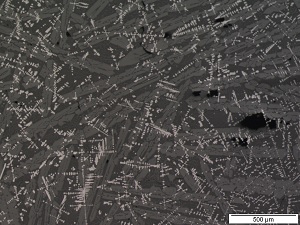
Can you provide a unique experience you have had whilst working at Cranfield?
One of the most unique and fortuitous experience happened on my second day at Cranfield. For several months previously, I had been developing ideas for a joint studentship application with scientists at ISIS Muon and Neutron Source at the STFC Rutherford Appleton Laboratory. We had been discussing the idea of a project looking at early Iron Age metalworking technologies in Iran using cutting edge non-destructive whole-object neutron imaging and analysis techniques. These metalworking technologies are remarkable for their complexity and have implications for understanding the process of early iron innovation in the Middle East and Central Asia. However, our plans had stalled as we had run into issues with identifying a collection that was accessible and feasible for study. Having just started at Cranfield the previous day, CFI director Andrew Shortland and British Museum curator St. John Simpson approached me about working on a collection consisting of precisely that type material, solving a major roadblock in the project. In December, I was notified that our application was successful, and I am thrilled to be able to offer a PhD studentship on the project starting later this year. This experience has been emblematic of the culture of collaboration and connection-building at Cranfield, even more remarkable in the context of the largely remote-working environment in the current circumstances.
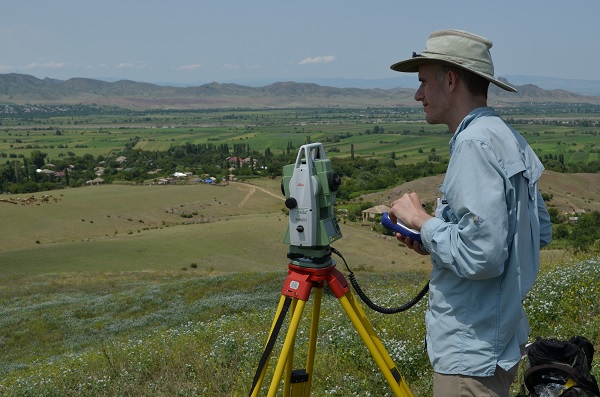
What’s a typical day at Cranfield? Day in office/working from home.
As it has for many archaeologists, the pandemic has radically shifted my patterns of work, forcing me to reschedule planned fieldwork, and prioritized desk-based research projects and grant-writing over lab work. One positive outcome has been the time and space to do a deep dive into some big-data synthesis projects that I had been mulling over for some time. A typical research day in the past few months might find me combing through 19th century excavation reports for information on quantities and dates of metal artefacts, or scrutinizing legacy chemical data for fresh insights into ancient recycling and alloying practices. Field and laboratory work delays has also opened up more time for writing project proposals and grant applications: I submitted five in 2020, of which three were successful and the other two are still under consideration. (Fingers crossed!) Though I dearly miss fieldwork—2020 is the first year since 2010 that I didn’t go the Caucasus, dreaming up new projects has made me look forward to seeing friends and colleagues there as soon as it is safe. My other major focus in the last few months has been the development of a new MSc. course on archaeological materials analysis, setting up meetings and drafting the documentation necessary for the rigorous internal approvals process. I look forward to times when a “typical day” involves more time in the laboratory, in the field, and the simple luxury of catching up with colleagues over an in-person lunch.
Find out more: Complex Metallurgy of the Bronze Age-Iron Age Transition in Iran: Archaeomaterials and Forensic Investigations PhD
Categories & Tags:
Leave a comment on this post:
You might also like…
Keren Tuv: My Cranfield experience studying Renewable Energy
Hello, my name is Keren, I am from London, UK, and I am studying Renewable Energy MSc. My journey to discovering Cranfield University began when I first decided to return to academia to pursue ...
3D Metal Manufacturing in space: A look into the future
David Rico Sierra, Research Fellow in Additive Manufacturing, was recently involved in an exciting project to manufacture parts using 3D printers in space. Here he reflects on his time working with Airbus in Toulouse… ...
A Legacy of Courage: From India to Britain, Three Generations Find Their Home
My story begins with my grandfather, who plucked up the courage to travel aboard at the age of 22 and start a new life in the UK. I don’t think he would have thought that ...
Cranfield to JLR: mastering mechatronics for a dream career
My name is Jerin Tom, and in 2023 I graduated from Cranfield with an MSc in Automotive Mechatronics. Originally from India, I've always been fascinated by the world of automobiles. Why Cranfield and the ...
Bringing the vision of advanced air mobility closer to reality
Experts at Cranfield University led by Professor Antonios Tsourdos, Head of the Autonomous and Cyber-Physical Systems Centre, are part of the Air Mobility Ecosystem Consortium (AMEC), which aims to demonstrate the commercial and operational ...
Using grey literature in your research: A short guide
As you research and write your thesis, you might come across, or be looking for, ‘grey literature’. This is quite simply material that is either unpublished, or published but not in a commercial form. Types ...

